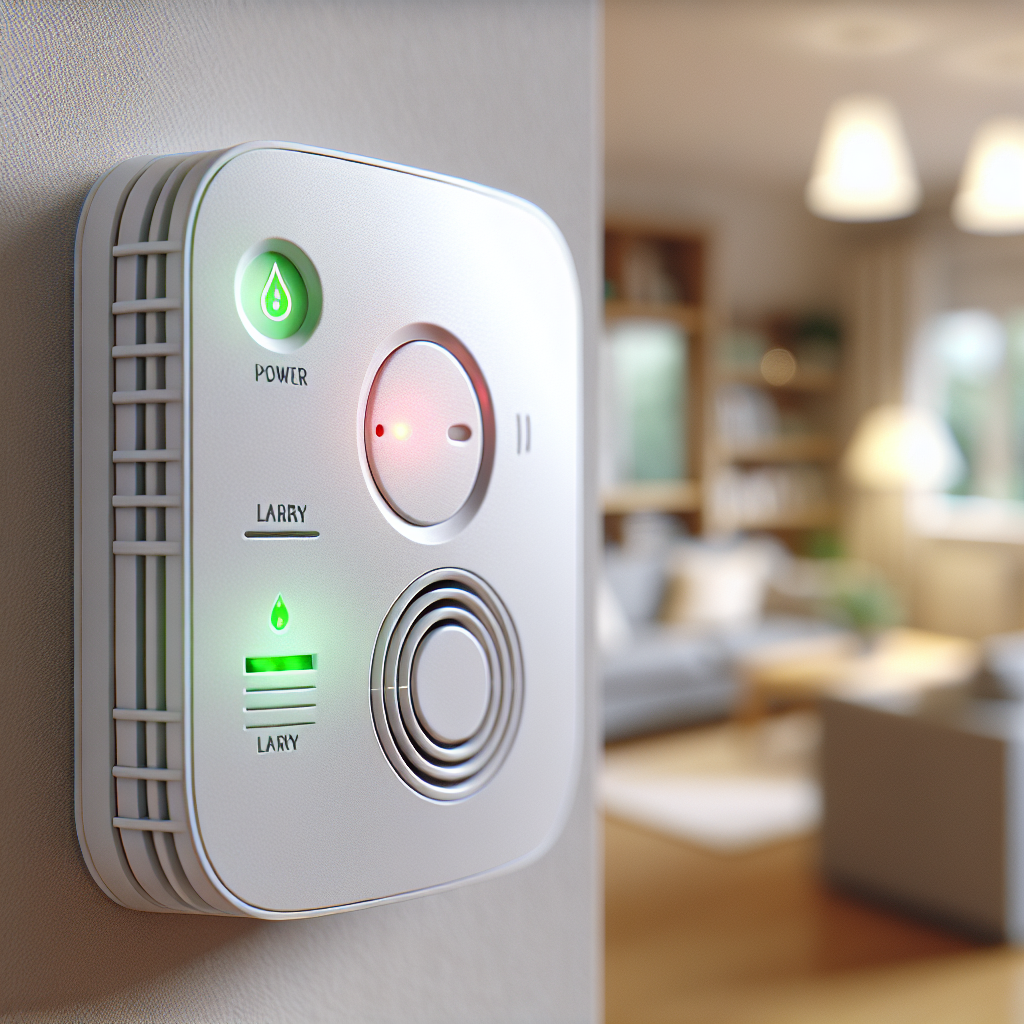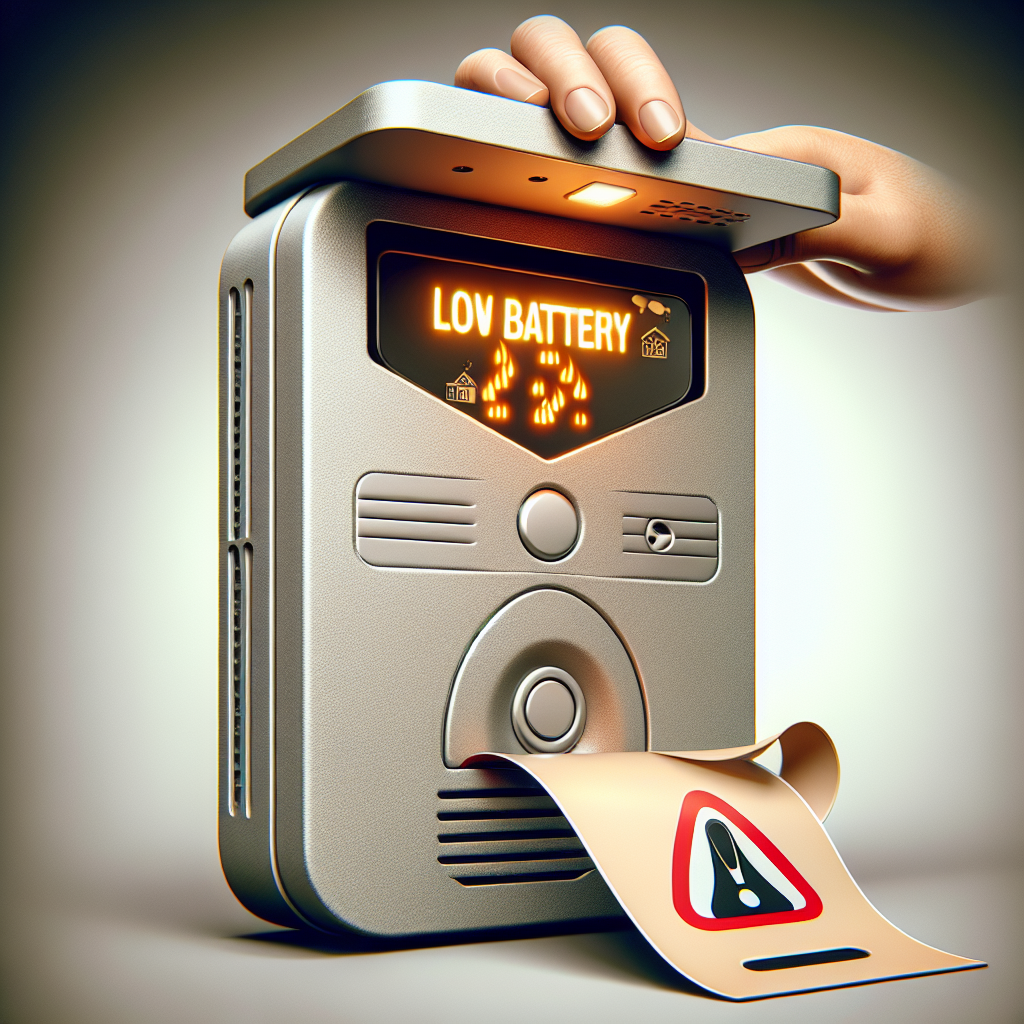CO alarms are essential devices in every home, providing a crucial layer of protection against the silent killer – carbon monoxide. But what if your CO alarm could do more than just alert you to dangerous levels of CO? Enter CO alarms with low battery indicators, a game-changer in home safety. These innovative devices not only sound the alarm when CO levels are high, but also conveniently notify you when the battery is running low. In this article, we will unveil the secrets behind these life-saving gadgets, exploring how they work and why they are a must-have for every household.
Understanding Carbon Monoxide (CO) Detection
What is Carbon Monoxide (CO)?
Carbon monoxide (CO) is a colorless, odorless gas that is produced by the incomplete combustion of carbon-based fuels such as gas, oil, wood, and coal. It is highly toxic and can be extremely dangerous even at low levels of exposure.
Why is CO dangerous?
CO is dangerous because it can interfere with the body’s ability to transport oxygen in the blood. When inhaled, CO binds to hemoglobin in the blood more readily than oxygen, leading to a reduction in the amount of oxygen that can be carried to vital organs like the brain and heart. This lack of oxygen can result in symptoms ranging from headaches and dizziness to unconsciousness and even death.
Importance of CO detection in homes
Detecting the presence of CO in the home is crucial for ensuring the safety of occupants. Because CO is undetectable by human senses, the installation of CO alarms is essential for early warning of dangerous levels of this gas. CO alarms with low battery indicators play a critical role in maintaining the effectiveness of these devices, ensuring that they are always operational when needed to protect against the silent threat of carbon monoxide poisoning.
How CO Alarms Work
Understanding Carbon Monoxide (CO) Detection
Carbon monoxide (CO) alarms are vital safety devices designed to detect the presence of this colorless, odorless gas in indoor environments. Understanding the intricate workings of CO alarms is crucial for ensuring their effectiveness in safeguarding against the dangers of CO poisoning.
Sensing Technology Used in CO Alarms
- Electrochemical Sensors: Most modern CO alarms utilize advanced electrochemical sensors to detect CO levels accurately. These sensors contain a chemical solution that reacts with CO, producing an electrical current that triggers the alarm.
- Biometric Sensors: Some CO alarms employ biometric sensors that can detect subtle changes in CO levels by measuring variations in airflow or temperature. These sensors offer enhanced sensitivity and can detect low levels of CO quickly.
- Smart Sensors: With advancements in technology, smart CO alarms have emerged that integrate advanced sensing technologies with connectivity features. These smart sensors can provide real-time monitoring and alerts, offering increased convenience and safety.
Activation and Alert Mechanisms
- Threshold Detection: CO alarms are programmed to trigger an alert when the CO concentration in the air reaches a certain threshold. This threshold is typically based on recognized safety standards to ensure timely detection of potentially harmful levels of CO.
- Audible Alarms: When the sensor detects elevated CO levels, the alarm system activates a loud, audible alert to warn occupants of the presence of this toxic gas. The alarm sound is designed to be distinctive and attention-grabbing to prompt immediate evacuation.
- Visual Indicators: In addition to audible alerts, many CO alarms are equipped with visual indicators, such as flashing lights or digital displays, to provide visual cues of the alarm status. These indicators can help individuals with hearing impairments or in noisy environments.
Role of Low Battery Indicator in CO Alarms
- Battery Power: CO alarms typically operate on batteries to ensure continuous functionality, even during power outages. The low battery indicator serves as a crucial feature to alert users when the battery power is running low, prompting them to replace the batteries promptly.
- Constant Monitoring: The low battery indicator continuously monitors the battery voltage or level to detect when it drops below a certain threshold. This proactive approach helps prevent the CO alarm from losing power unexpectedly, ensuring uninterrupted protection against CO exposure.
- Maintenance Reminder: Beyond indicating low battery levels, the low battery indicator also serves as a maintenance reminder for users to perform regular checks on their CO alarms. This proactive maintenance approach helps ensure the long-term reliability and effectiveness of the CO alarm in detecting CO gas.
Benefits of CO Alarm with Low Battery Indicator

– Enhanced safety features: CO alarms with low battery indicators provide an added layer of safety by ensuring that the alarm is always powered and functional. This feature helps prevent situations where the alarm fails to sound due to a depleted battery, potentially putting occupants at risk of carbon monoxide exposure. By alerting users to low battery levels, these alarms help maintain continuous monitoring and detection of this silent killer.
- Timely maintenance reminders: The low battery indicator on CO alarms serves as a built-in maintenance reminder for homeowners. When the indicator signals a low battery, it prompts users to replace the batteries promptly, ensuring that the alarm remains operational at all times. This proactive approach to maintenance helps prevent unnecessary gaps in protection and promotes a responsible attitude towards the upkeep of essential safety devices in the home.
- Peace of mind for homeowners: Knowing that a CO alarm with a low battery indicator is actively monitoring the indoor air for carbon monoxide provides homeowners with peace of mind. The presence of this feature offers reassurance that the alarm is functioning correctly and that potential battery issues will be promptly addressed. This sense of security allows residents to go about their daily lives without the worry of whether their CO alarm is in proper working order, contributing to a safer and more comfortable living environment.
Misconceptions about Low Battery Indicators
- Misconception 1: Ignoring the Low Battery Indicator is Safe
- Contrary to popular belief, ignoring the low battery indicator on a CO alarm is not safe. The indicator serves as a crucial warning that the device may not function properly in case of a carbon monoxide leak.
- Misconception 2: Low Battery Indicators Are Just a Minor Inconvenience
- Some individuals perceive low battery indicators as a minor inconvenience that can be disregarded. However, failing to address low battery alerts promptly can lead to the CO alarm not working when needed the most, putting lives at risk.
- Misconception 3: New Batteries Are Not Necessary When Low Battery Indicator Appears
- A common misconception is that simply resetting the CO alarm after the low battery indicator appears is sufficient. In reality, replacing the batteries with new ones is essential to ensure the alarm functions effectively in detecting carbon monoxide levels.

Choosing the Right CO Alarm with Low Battery Indicator
When it comes to selecting a CO alarm with a low battery indicator, there are several crucial factors that should be taken into consideration to ensure optimal safety and functionality.
- Accuracy and Sensitivity: One of the primary considerations when choosing a CO alarm is its accuracy in detecting carbon monoxide levels. Look for alarms that are highly sensitive to even low levels of CO, as this can provide early warnings before concentrations become dangerous.
- Low Battery Indicator: The presence of a low battery indicator is essential for ensuring that the CO alarm remains functional at all times. This feature alerts users when the battery needs to be replaced, preventing the alarm from failing due to lack of power.
- Power Source: Consider whether the CO alarm operates on batteries, electricity, or a combination of both. Battery-operated alarms are portable and continue to function during power outages, while hardwired alarms offer constant power supply but may require professional installation.
- End-of-Life Warning: Some advanced CO alarms come equipped with an end-of-life warning feature that signals when the device has reached the end of its lifespan. This proactive alert ensures that the alarm is replaced before it loses its effectiveness.
- Interconnectivity: For enhanced safety in larger homes or buildings, opting for CO alarms that can be interconnected is advisable. Interconnected alarms trigger all units to sound simultaneously when one detects CO, providing comprehensive coverage throughout the property.
- Compliance and Certification: Prioritize CO alarms that meet industry standards and certifications to guarantee their reliability and effectiveness. Look for alarms that comply with regulations such as UL (Underwriters Laboratories) certification for added peace of mind.
By carefully evaluating these factors and comparing different models and brands, individuals can choose a CO alarm with a low battery indicator that not only meets their specific needs but also prioritizes safety and reliability.
Installation and Maintenance Tips
Choosing the Right CO Alarm with Low Battery Indicator
Proper placement of CO alarms in the home
– Placement Considerations: When installing CO alarms in the home, it is crucial to place them in key areas where carbon monoxide buildup is most likely to occur. This includes near bedrooms, close to fuel-burning appliances like furnaces or water heaters, and on every level of the home including the basement.
– Avoiding Obstructions: Ensure that CO alarms are not obstructed by furniture, curtains, or any other objects that could hinder their effectiveness. Installing them at least 5 feet above the ground and away from windows, doors, or vents is recommended for optimal performance.
Testing and replacing batteries in CO alarms
– Regular Testing: It is essential to test CO alarms monthly to ensure they are functioning correctly. Most models have a “test” button that can be pressed to check the alarm sound.
– Battery Replacement: CO alarms with low battery indicators will typically emit a specific sound or light signal to indicate when the batteries are running low. It is crucial to replace the batteries promptly to ensure continuous protection against carbon monoxide exposure.
Regular maintenance practices for optimal performance
– Cleaning and Dusting: Regularly clean CO alarms with a soft brush or vacuum attachment to remove dust and debris that could affect their sensors. Dust accumulation can interfere with the alarm’s ability to detect carbon monoxide levels accurately.

– Annual Maintenance: Consider scheduling an annual inspection of your CO alarms by a professional to verify their functionality and address any potential issues promptly. This proactive approach can help ensure that your alarms are in optimal condition to provide early warnings of carbon monoxide presence.
Responding to Low Battery Alerts
- Understanding Different Low Battery Indicators
CO alarms with low battery indicators typically emit a short chirping sound at regular intervals to signal that the battery power is running low. These alerts are crucial as they ensure that the alarm remains operational at all times. Some models may also display a visual indicator such as a flashing light or a specific symbol on the digital screen to indicate a low battery situation. Understanding the specific low battery indicator of your CO alarm is essential for prompt action.
- Steps to Take When the Low Battery Alert Activates
When the low battery alert activates on your CO alarm, the first step is to locate the source of the alert. Once you have identified that the alert is indeed related to the low battery, you should immediately replace the battery with a new one. It is recommended to use high-quality batteries to ensure the continued effectiveness of the CO alarm. After replacing the battery, test the alarm to confirm that the low battery alert has been resolved.
- Troubleshooting Common Issues with CO Alarms
In some cases, even after replacing the battery, the low battery alert may persist. This could indicate a deeper issue with the CO alarm itself. In such instances, it is advisable to refer to the user manual provided by the manufacturer for troubleshooting steps. Common issues that may cause persistent low battery alerts include improper installation, sensor malfunctions, or internal circuitry problems. If troubleshooting steps do not resolve the issue, contacting the manufacturer or a certified technician for further assistance is recommended.
Integrating CO Alarms into Home Security Systems
Incorporating carbon monoxide (CO) alarms into home security systems has become increasingly popular due to the numerous benefits it offers. These integrated systems provide a comprehensive approach to safeguarding homes from the dangers of CO exposure. Below are some key points highlighting the advantages of integrating CO alarms with home security systems:
- Benefits of integrating CO alarms with home security systems: By combining CO alarms with existing home security systems, homeowners can enjoy enhanced protection against this silent killer. The integration allows for seamless monitoring of CO levels in addition to traditional security features, providing a more robust safety net for residents.
- Smart technology features for CO detection: Modern CO alarms integrated into home security systems often come equipped with smart technology features. These advanced capabilities enable remote monitoring and control of CO levels through mobile apps or centralized control panels. This real-time data access enhances responsiveness in case of a CO leak, ensuring prompt action to mitigate risks.
- 24/7 monitoring and alerts for added security: One of the significant advantages of integrating CO alarms with home security systems is the round-the-clock monitoring and alerts. With constant surveillance, any deviations in CO levels can trigger immediate alerts to homeowners or monitoring services. This proactive approach helps prevent CO-related incidents and ensures swift intervention when necessary.
By integrating CO alarms into home security systems, homeowners can elevate their safety measures and gain peace of mind knowing that their loved ones are protected from the invisible threat of carbon monoxide.
FAQs: Unveiling the Secrets of CO Alarms with Low Battery Indicators
What is a CO alarm with low battery indicator?
A CO alarm with a low battery indicator is a device designed to detect the presence of carbon monoxide gas in the air and alert individuals to potential danger. In addition to monitoring CO levels, these alarms also have a feature that notifies you when the battery is running low and needs to be replaced.
How does the low battery indicator work on a CO alarm?
The low battery indicator on a CO alarm typically functions by emitting a specific pattern of beeps or flashing lights to alert you that the battery needs to be changed. This warning ensures that your CO alarm remains operational and can continue to protect you and your family from the dangers of carbon monoxide exposure.
Why is it important to replace the battery in a CO alarm when the low battery indicator goes off?
Replacing the battery in a CO alarm when the low battery indicator goes off is crucial to ensure that the device continues to function properly. Without a functioning battery, the alarm may fail to alert you to elevated levels of carbon monoxide in your home, putting you at risk of illness or even death. Regularly checking and replacing the battery in your CO alarm is a simple yet vital step in maintaining a safe and healthy living environment.
How often should the battery in a CO alarm be replaced?
It is recommended to replace the battery in a CO alarm at least once a year to ensure optimal performance. Some manufacturers may provide specific guidelines on battery replacement intervals, so be sure to consult the instructions that come with your device. Additionally, it is a good practice to test your CO alarm regularly to ensure that both the detector and the battery are functioning correctly.
Are there any other maintenance steps that should be taken with a CO alarm with a low battery indicator?
In addition to replacing the battery when the low battery indicator goes off, it is also important to perform regular maintenance on your CO alarm. This includes testing the alarm regularly, keeping it clean and free of dust or debris, and ensuring that it is installed in a location where it can effectively detect carbon monoxide gas. Following these maintenance steps will help ensure that your CO alarm remains reliable and effective in keeping you safe from the dangers of CO exposure.